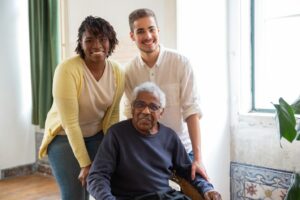
Supporting senior health in communities is increasingly important as the population ages. Ensuring that older adults remain healthy and active can significantly improve their quality of life and reduce healthcare costs.
This article explores practical strategies to support senior health, focusing on promoting physical activity, enhancing health education, improving access to healthcare, fostering social connections, and providing nutritional support.
1. Promote Physical Activity
Regular physical activity is crucial for maintaining health and independence in seniors. Exercise helps to improve cardiovascular health, maintain muscle strength, and enhance flexibility and balance, which are essential for preventing falls. Communities can encourage physical activity by organizing group exercise classes tailored to seniors, such as yoga, tai chi, and water aerobics. These classes not only provide physical benefits but also offer social interaction, which can boost mental health.
Moreover, communities can create safe and accessible spaces for seniors to walk, such as parks with well-maintained walking paths and benches for resting. Senior-friendly sports leagues and clubs can also motivate older adults to stay active. By promoting various forms of physical activity, communities can help seniors maintain their health and enjoy an active lifestyle.
2. Enhance Health Education
Health education is a powerful tool for empowering seniors to take charge of their health. Educational programs can cover a range of topics, including chronic disease management, medication safety, and healthy lifestyle choices. Community centers and senior organizations can host workshops and seminars to provide this valuable information.
For those interested in a deeper understanding of public health, pursuing a public health education degree can be a rewarding option. This not only benefits the individual but also enables them to contribute more effectively to community health initiatives. Local institutions can offer courses and certifications tailored to seniors, making it easier for them to access and complete these programs.
Health education can also be disseminated through newsletters, online platforms, and local media, ensuring that all seniors have access to the information they need to make informed health decisions.
3. Improve Access to Healthcare Services
Accessibility to healthcare services is a critical factor in supporting senior health. Many seniors face challenges such as limited mobility, lack of transportation, and financial constraints that can prevent them from accessing necessary care. Communities can address these issues by providing transportation services specifically for seniors, such as shuttle buses to medical appointments.
Mobile health clinics can bring healthcare services directly to seniors, especially those living in rural or underserved areas. These clinics can offer routine check-ups, screenings, and vaccinations, reducing the need for seniors to travel long distances.
Telehealth services have become increasingly important, offering seniors the ability to consult with healthcare providers from the comfort of their homes. By improving access to healthcare, communities can ensure that seniors receive timely and appropriate care, which is vital for maintaining their health.
4. Foster Social Connections
Social connections are essential for mental and emotional well-being. Many seniors experience loneliness and isolation, which can negatively impact their health. Communities can help by creating opportunities for social engagement through senior centers, clubs, and community events.
Senior centers can offer a variety of activities, such as arts and crafts, games, and educational classes, providing a place for seniors to meet and interact with others. Volunteering opportunities can also be beneficial, allowing seniors to stay active and involved in their communities.
Intergenerational programs, where seniors and younger people engage in activities together, can also foster meaningful relationships and combat isolation. By fostering social connections, communities can enhance the overall well-being of their senior residents.
5. Provide Nutritional Support
Nutrition plays a vital role in maintaining senior health. A balanced diet helps prevent chronic diseases, supports immune function, and promotes overall well-being. Communities can support seniors by offering nutritional education and meal services.
Nutrition workshops can teach seniors about the importance of a balanced diet and how to make healthy food choices. Cooking classes can provide practical skills for preparing nutritious meals at home. For seniors with limited mobility or financial resources, community meal programs can ensure they receive regular, healthy meals.
Programs like Meals on Wheels deliver nutritious meals directly to seniors’ homes, ensuring they have access to healthy food even if they are unable to shop or cook for themselves. Community gardens and farmers’ markets can also provide fresh produce, encouraging seniors to eat healthily.
6. Promote Preventive Care
Preventive care is vital for detecting health issues early and managing chronic conditions. Regular health screenings, such as blood pressure checks, cholesterol tests, and cancer screenings, can help identify potential problems before they become serious. Vaccinations, including flu and pneumonia shots, are also essential for preventing illnesses that can be particularly severe in older adults.
Communities can facilitate preventive care by organizing health fairs and providing easy access to screening services. Collaboration with local healthcare providers can ensure that seniors receive comprehensive preventive care. Public health campaigns that emphasize the importance of regular check-ups and vaccinations can encourage seniors to stay proactive about their health. By prioritizing preventive care, communities can help seniors lead healthier and longer lives.
7. Support Caregivers
Caregivers play a crucial role in the health and well-being of seniors. However, caregiving can be physically and emotionally demanding, often leading to burnout. Communities can support caregivers by providing resources and respite care services. Respite care offers temporary relief for caregivers, allowing them to rest and recharge.
Training programs for family and professional caregivers can enhance their skills and knowledge, ensuring they provide the best possible care. Support groups and counseling services can also help caregivers manage stress and connect with others in similar situations. By supporting caregivers, communities can improve the quality of care that seniors receive and ensure that caregivers maintain their health and well-being.
To Sum It Up
Supporting senior health in communities requires a comprehensive approach. By implementing these strategies, communities can create a supportive and inclusive environment where seniors can thrive.
These efforts are essential for ensuring that seniors lead healthy, fulfilling lives and that they receive the care and respect they deserve.









